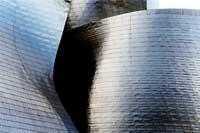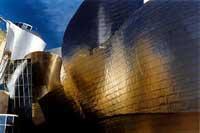The Guggenheim sparkles again

Given these characteristics of titanium, no problem was expected at the Guggenheim Museum. But since the museum opened, it has been a long time, and four years ago, the elegant costume of the most emblematic building in Bilbao, little by little, the stains appeared. This happened last year. Aware of the problem, the museum authorities have commissioned numerous investigations during this time to decide how to clean titanium stains. Finally, the Inasmet Technology Center in San Sebastian will take advantage of the invented system and soon the Guggenheim Museum will once again look elegant forever.
The product invented by the technology center of San Sebastian is, in short, a foam that is thrown at pressure on the plate, it is given a couple of minutes to do its work, it is absorbed and finally, if there is any small foam that has not been absorbed, the plate is cleaned with water.
To be able to invent the new product, Inasmet researchers have had several drawbacks: some technicians – difficulties in getting the product itself – and others formal – the solution necessarily had to have some characteristics determined by the museum authorities. That is, the solution could not influence the appearance of the original material, nor the roughness, nor the color, nor the brightness. At the same time, the use of scaffolding and delamination was not allowed for the cleaning of the plates. In addition, the solution should be quick and not harm the environment.
Therefore, Inasmet had to devise a system that fulfilled all these characteristics to find a solution that would return to the exterior of the Guggenheim Museum its natural appearance. The work started from analyzing the problem. "What happened? First we tried to answer the question, says Alberto Pelayo, researcher at Inasmet. We studied the stains and realized that these were due to the atmosphere of Bilbao and the works that have been made in the area of the museum. If titanium itself has a small layer that is not seen, under normal conditions of about 3 nanometers, in this case we saw that it had grown up to 8 nanometers, due to excessive oxidation. On the one hand, natural titanium oxide and silica have been stacked here. These silicates are dust from stones cut in the works that have been made in the area, very small particles. They are actually inert, but they have facilitated the process of layer enlargement."
However, what happened did not seem so simple, since the Guggenheim Museum had been extracted black spots in some places and in others, long spots in the form of spills. In the technological center of San Sebastian two types of stains were analyzed. "Yes, and we realized that they had the same origin, although it appeared in different ways. The places where black spots appeared are places where the rain normally does not come, that is, they are not cleaned with rainwater. The other, corresponding to the path that always takes water when it rains. The rain itself is not bad, because it cleans the plates. But if it does not reach some places, those places are not cleaned, and if in others it carries too much water, the material that carries the water alone can remain in the drying".
Although all the benefits of the Inasmet system have recognized it, it has not been easy to find a solution. "We knew what the problem was, but it has cost us more to find the solution. At first we mixed water with an alkaline product, which is pressurized to the plates, then steam, vinegar and an alkaline product were used… but nothing served. Finally we bet on the foam, because the foam does not dirty the original material, it can be used in certain areas and, once used, can be sucked."

However, the foam they have developed at Inasmet is not of any kind, they call it impossible foam. "We say it is impossible because in the same mixture we have an acid – effective agent – and a water-soluble polymer – thickener. In turn, we have a surfactant, stabilizer, indicator and liquefied gas – inert and not harmful to the environment. The most important work has been to be stable and effective in the necessary time, sometimes we fell the foam, other times managed to stabilize it but had no effect… Finally, we got a product that can be assimilated to the photographic development, we revealed or cleaned effective agents, the stabilizer brakes or fixed the influence of the effective agent, we vacuum the product and finally clean it with water”. Concrete elements of impossible foam, of course, are secrets.
On the occasion of the cleaning of the Guggenheim, this problem has had a great presence in the media. And the problem will be repeated, but it does not seem to attract the attention of the media. "Eventually it gets dirty again, but it doesn't have to cause problems. Now, once the general cleaning is finished, they will have to put the cleaning of titanium into the usual maintenance protocol, as is done to clean the crystals or pass the broom."
Until it is decided that the Inasmet system is the best solution, the Guggenheim has had several options. The American company Timet, which manufactured titanium plates, also presented its proposal. According to the Americans, the most appropriate solution was to clean the plates with electrolysis. The cleaning process with electrolysis is simple and effective in laboratories, but it was another thing to do in the museum itself. The Guggenheim Museum has 42,800 titanium sheets and, using the Timet system, each of them took about 20 minutes to clean. Therefore, in addition to the cleaning work being very slow, with this system would be expensive.
Buletina
Bidali zure helbide elektronikoa eta jaso asteroko buletina zure sarrera-ontzian











